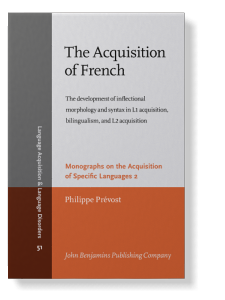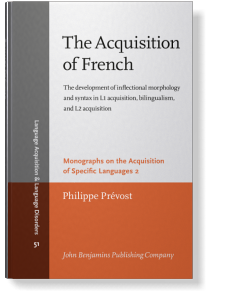The Acquisition of French
The development of inflectional morphology and syntax in L1 acquisition, bilingualism, and L2 acquisition
Author
This book presents a thorough description of morphosyntactic knowledge developed by learners of French in four different learning situations — first language (L1) acquisition, second (L2) language acquisition, bilingualism, and acquisition by children with Specific Language Impairment — within the theoretical framework of generative grammar. This approach allows for multiple comparisons across acquisition contexts, which provides the reader with invaluable insights into the nature of the acquisition process. The book is divided into four parts each dealing with a major morphosyntactic domain of acquisition: the verbal domain, the pronominal domain, the nominal domain, and the CP domain. Each part contains four chapters, the first one presenting an overview of the basic facts and analyses of the relevant properties of French, and the next three focusing on the different acquisition contexts. This book will be useful to anyone interested in the acquisition of French and in language development in general. It is also meant to stimulate cross-linguistic research from a theoretical perspective.
[Language Acquisition and Language Disorders, 51] 2009. xx, 458 pp.
Publishing status: Available
© John Benjamins Publishing Company
Table of Contents
-
Preface | pp. i–xx
-
Introduction | pp. 1–14
-
Part I. The verbal domain
-
Chapter 1. The verbal domain: Syntactic assumptions | pp. 17–26
-
Chapter 2. The verbal domain in child L1 French | pp. 27–54
-
Chapter 3. The verbal domain in French bilingual acquisition and in children with SLI learning French | pp. 55–76
-
Chapter 4. The verbal domain in French L2 acquisition | pp. 77–112
-
Part II. Subject and object pronouns
-
Chapter 5. Subject and object pronouns: Morphosyntactic background | pp. 115–130
-
Chapter 6. Subject and object pronouns in child L1 French | pp. 131–178
-
Chapter 7. Subject and object pronouns in French bilingual acquisition and in children with SLI learning French | pp. 179–202
-
Chapter 8. Subject and object pronouns in L2 French acquisition | pp. 203–232
-
Part III. Determiner phrases
-
Chapter 9. Determiner phrases: Morphosyntactic assumptions | pp. 235–250
-
Chapter 10. Determiner phrases in child L1 French | pp. 251–266
-
Chapter 11. The development of DPs in French bilingual acquisition and in children with SLI learning French | pp. 267–288
-
Chapter 12. Determiner phrases in L2 French acquisition | pp. 289–320
-
Part IV. Questions and embedded clauses
-
Chapter 13. Questions and embedded clauses in French: Facts and analyses | pp. 323–344
-
Chapter 14. Questions and embedded clauses in child L1 French | pp. 345–372
-
Chapter 15. The development of questions and embedded clauses in French bilingual acquisition and in children with SLI learning French | pp. 373–388
-
Chapter 16. Questions and embedded clauses in L2 French acquisition | pp. 389–412
-
Conclusion | pp. 413–424
-
-
Author index | pp. 449–452
-
Subject index | pp. 453–458
“An excellent introduction to anyone who is interested in the acquisition of French, this volume provides an overview of and begins to bridge the gap between various learning situations. [...] With the ambitious goal of providing a description of the acquisition of French in different learning situations, Prévost must be commended for his efforts in providing a critical discussion of the different learning situations that deal with the acquisition of French. [...] this volume is recommended for anyone who is interested in discovering what has been said about the acquisition of French in various learning situations. Moreover, Prévost offers many research ideas throughout the book, thus fulfilling his third objective. Covering such a breadth of information, this volume should soon become a reference for those studying the acquisition of French.”
Claire Renaud, Arizona State University, in Studies in Second Language Acquisition 33(3): 464-466.
“With this comprehensive and extremely well-written monograph on the acquisition of French in several contexts, Philippe Prévost has accomplished a scholarly tour de force sure to please a wide audience. The book will certainly interest applied French linguists, especially those focusing on acquisition. Given its meticulous attention to the acquisition of morphosyntactic phenomena in both L1 (first language) and L2 (second language) contexts - including bilingual child language acquisition and acquisition by French L1 children with specific linguistic impairments (SLI) - the book will also merit a large readership among all acquisition researchers. In addition, Prévost brings a wealth of acquisition data to bear on important theoretical questions in the Universal Grammar (UG)/Minimalist Program and highlights the contributions that French acquisition research has made to the development of both syntactic and acquisition theory.”
Mary Ellen Scullen, University of Maryland, College Point, in French Review 84(6): 1349-1350
“With this comprehesive and extremely well-written monograph in the acquisition of French in several contexts, Phillipe Prévost has accomplished a scholarly 'tour de force' sure to please a wide audience. The book will certainly interest applied French linguists, especially those focusing on acquisition. Givens its meticulous attention to the acquisition of morphosyntactic phonomena in both L1 (first language) and L2 (second language) contexts - including bilingual child language acquisition and acquisition by French L1 children with specific linguistic impairments (SLI) - the book will also merit a large readership among all acquisition researchers. In addition, Prévost brings a wealth of acquisition data to bear on important theoretical questions in the Universal Grammar (UG)/Minimalist Program and highlights the contributions that French acquisition research has made to the development of both syntactic and acquisition theory.”
Mary Ellen Scullen, University of Maryland, College Point, in French Review *4(6): 1349-50
Cited by (50)
Cited by 50 other publications
Fonseca-Greber, Bonnie B.
2023. William J. Ashby – A pioneer in diachronic Spoken French corpus linguistics. In On Spoken French [Studies in Language Companion Series, 226], ► pp. 1 ff. 
Kpoglu, Promise Dodzi
Moscati, Vincenzo, Andrea Marini & Nicoletta Biondo
Müller, Natascha
Müller, Natascha
Palasis, Katerina, Richard Faure & Fanny Meunier
Stanford, Emily & Hélène Delage
van Dijk, Chantal & Sharon Unsworth
Franck, Julie & Despina Papadopoulou
Pirvulescu, Mihaela, Virginia Hill, Nadia Nacif, Rena Helms-Park & Maria Petrescu
Chilla, Solveig, Cornelia Hamann, Philippe Prévost, Lina Abed Ibrahim, Sandrine Ferré, Christophe dos Santos, Racha Zebib & Laurice Tuller
2021. The influence of different first languages on LITMUS nonword-repetition and sentence repetition in second language French and second language German. In Language Impairment in Multilingual Settings [Trends in Language Acquisition Research, 29], ► pp. 228 ff. 
Henri, Fabiola
Howard, Martin
Scalise, Elena, Johanna Stahnke & Natascha Müller
Scheidnes, Maureen, Laurice Tuller & Philippe Prévost
2021. Object clitic production in French-speaking L2 children and children with SLI. Linguistic Approaches to Bilingualism 11:2 ► pp. 259 ff. 
Thomas, Anita
DELAGE, Hélène & Ulrich Hans FRAUENFELDER
Edmonds, Amanda, Aarnes Gudmestad & Thomas Metzger
Scheidnes, Maureen
Ågren, Malin, Marie-Eve Michot, Cyrille Granget, Sonia Gerolimich, Pascale Hadermann & Isabelle Stabarin
Palasis, Katerina, Richard Faure & Frédéric Lavigne
Shimanskaya, Elena & Roumyana Slabakova
Antonova Ünlü, Elena & Li Wei
Côté, Stephanie
Delage, Hélène & Stephanie Durrleman
GRANFELDT, JONAS
Herschensohn, Julia & Randall Gess
HERVÉ, Coralie & Ludovica SERRATRICE
Karpathiou, Nomiki, John Papatriantafyllou & Maria Kambanaros
Poehner, Matthew E. & Rémi A. van Compernolle
Poehner, Matthew E. & Rémi A. van Compernolle
Roberge, Yves, Ana Teresa Pérez-Leroux & Anna Frolova
Shimanskaya, Elena
2018. Chapter 3. Another look at L2 acquisition of French clitics and strong pronouns. In Meaning and Structure in Second Language Acquisition [Studies in Bilingualism, 55], ► pp. 67 ff. 
Fotiadou, Georgia & Hélène Vassiliadou
2017. Transitivity and valency: from theory to acquisition.
Lingvisticae Investigationes
40:1 ► pp. 1 ff. 
Pérez-Leroux, Ana Teresa, Mihaela Pirvulescu, Yves Roberge & Nelleke Strik
2017. Clitics as input to the acquisition of verbal transitivity in French. Lingvisticae Investigationes 40:1 ► pp. 117 ff. 
Ud Deen, Kamil
Haznedar, Belma & F. Nihan Ketrez
2016. Introduction. In The Acquisition of Turkish in Childhood [Trends in Language Acquisition Research, 20], ► pp. 1 ff. 
Pozniak, Céline & Barbara Hemforth
Chondrogianni, Vicky
2015. Production and comprehension of pronouns and reflexives in atypical populations. In The Acquisition of Reference [Trends in Language Acquisition Research, 15], ► pp. 285 ff. 
AYOUN, DALILA
Roberge, Yves & Nelleke Strik
Ågren, Malin, Jonas Granfeldt & Anita Thomas
2014.
Combined effects of age of onset and input on the development of different grammatical structures. Linguistic Approaches to Bilingualism 4:4 ► pp. 462 ff. 
BARRA-JOVER, MARIO
PALASIS, KATERINA
Rizzi, Silvana, Laia Arnaus Gil, Valentina Repetto, Jasmin Geveler & Natascha Müller
ÅGREN, MALIN & JOOST VAN DE WEIJER
Ågren, Malin & Joost van de Weijer
2019. The production of preverbal liaison in Swedish learners of L2 French. Language, Interaction and Acquisition. Langage, Interaction et Acquisition 10:1 ► pp. 117 ff. 
Andreassen, Helene N.
[no author supplied]
[no author supplied]
This list is based on CrossRef data as of 18 july 2024. Please note that it may not be complete. Sources presented here have been supplied by the respective publishers. Any errors therein should be reported to them.
Subjects
Main BIC Subject
CFK: Grammar, syntax
Main BISAC Subject
LAN009000: LANGUAGE ARTS & DISCIPLINES / Linguistics / General

